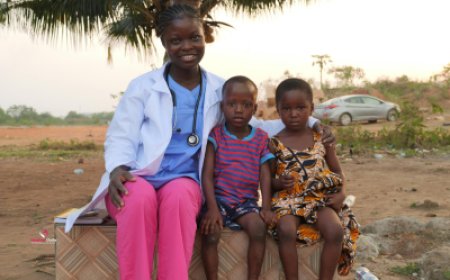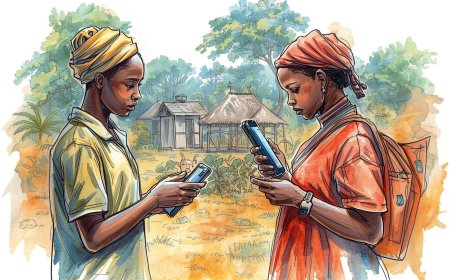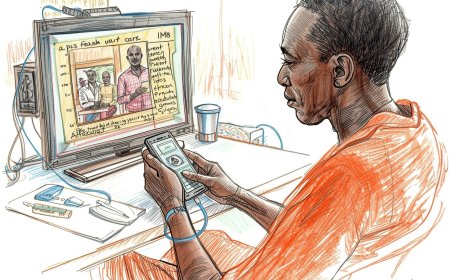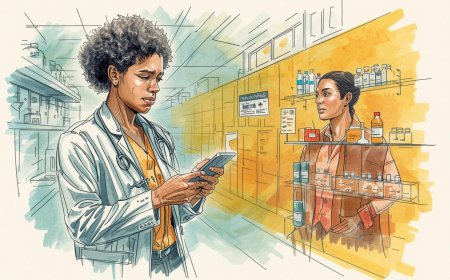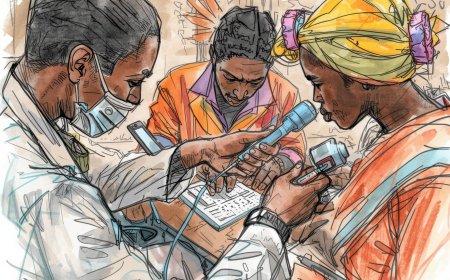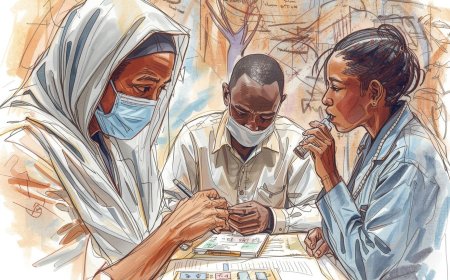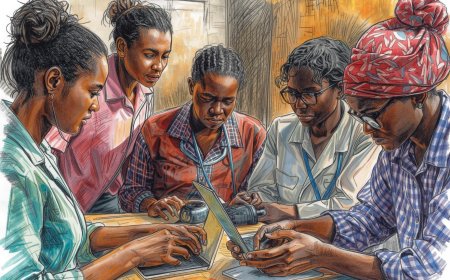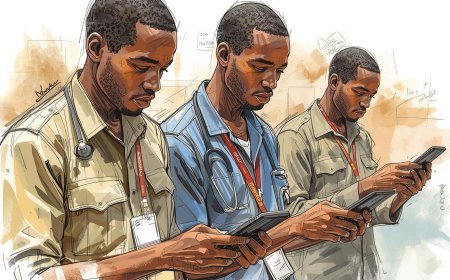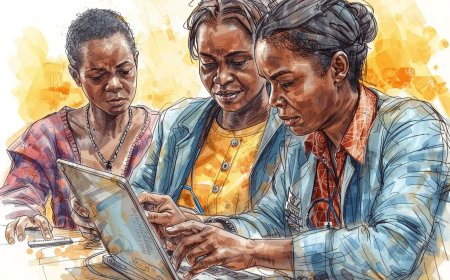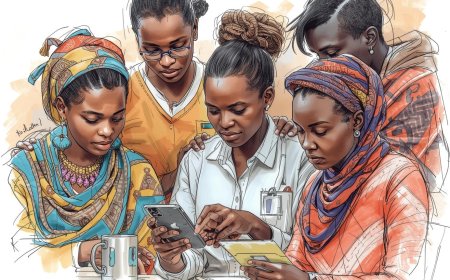Training Community Health Workers on Mobile Apps: Curriculum and Mentorship Models for Africa
This APA-style article for an African audience presents a practical curriculum and mentorship models for training community health workers (CHWs) to use mobile health applications. It synthesises evidence and guidelines, describes a step-by-step curriculum (core competencies, learning objectives, blended delivery), offers sustainable mentorship and supervision models (cascade, peer, remote, blended), and provides assessment, monitoring, budgeting, and policy recommendations tailored to resource-constrained African settings. Includes a 12-step implementation checklist, sample 6-week training plan, and evaluation templates founders, MOH teams, NGOs, and implementing partners can use.
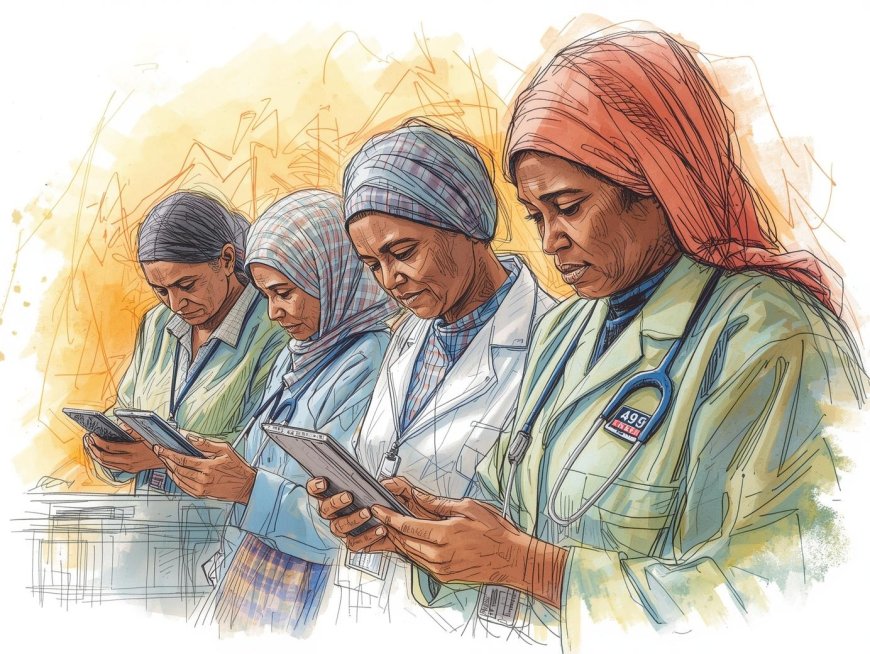
Abstract
Mobile applications are increasingly central to CHW programs across Africa — for case management, reporting, referrals, and health education. Effective deployment requires more than handing devices to CHWs: it requires a structured curriculum that teaches digital literacy, clinical workflows, data quality, privacy, troubleshooting, and soft skills; plus a sustainable mentorship and supervision model that preserves quality as scale grows. This article synthesises WHO guidance and peer-reviewed evidence to propose a practical, low-cost curriculum and three mentorship models (cascade, peer-cohort, remote-supervisor) adapted to African realities. We provide actionable session plans, assessment methods, monitoring metrics, budgeting considerations, and a 12-step implementation checklist to help ministries, NGOs, and startups move from pilot to durable impact. Community Health Impact Coalition+2PMC+2
Introduction
Community health workers (CHWs) are the backbone of primary and community health across Africa. Mobile health (mHealth) applications can extend CHW reach, improve guideline adherence, speed referrals, and strengthen surveillance — but these benefits only materialize when CHWs are properly trained and supported. Training must cover the app and the clinical and social workflows it embeds, and must be reinforced by ongoing mentorship, supervision, and performance feedback. The WHO, regional initiatives, and multiple implementation studies highlight the importance of capacity strengthening, combined digital and in-person training, and governance to achieve scale and quality. Community Health Impact Coalition+1
Why a dedicated CHW mobile-app curriculum matters
-
Digital literacy varies widely. Many CHWs are experienced health workers but unfamiliar with smartphones, data entry conventions, or offline-first apps; training must start with practical device and data skills. PMC
-
Clinical safety depends on correct app use. Poor use (data entry errors, skipped decision nodes) undermines clinical decision-support and surveillance quality. Training must therefore interleave clinical scenarios with app use. PMC
-
Sustainability requires supervision and mentorship. Single training workshops lead to skill fade; mentorship and on-the-job coaching maintain quality and support problem solving. Evidence supports blended learning plus supervision as a durable approach. BMJ Open+1
Curriculum design principles (how to design it)
-
Competency-based: Define observable competencies (can complete a home visit using app X; can register and refer a danger sign; can resolve sync errors). Align assessments to competencies. CHW Central
-
Blended delivery: Combine short in-person orientation, hands-on practical labs, mobile microlearning (SMS/USSD/WhatsApp or in-app modules), and supervised field practice. Blended models increase retention and reach. frontlinehealthworkers.org+1
-
Contextualised content: Localise language, case-mix, referral pathways, and job aids to match national guidelines and device types. wvi.org
-
Spaced practice & mentorship: Reinforce learning with regular mentor visits, peer review, and digital refreshers to prevent skill decay. BMJ Open
-
Measure and iterate: Embed monitoring (data quality checks, observed consultations) and use findings to refine modules and mentorship focus. PMC
Core curriculum: modules, competencies, and sample learning activities
Below is a recommended modular curriculum usable for a 4–6 week blended programme (adjust duration to context).
Module 0 — Orientation & programme onboarding (half day)
Competencies: understands programme goals, reporting lines, device care rules, and data privacy basics.
Activities: programme briefing, device issuance and checklist, consent & confidentiality discussion.
Module 1 — Basic digital & device literacy (1–2 days)
Competencies: power on/off, charge management, navigate OS, open app, basic typing, offline caching, sync.
Activities: hands-on device labs, troubleshooting common battery/connectivity issues, short micro-lessons.
Module 2 — Clinical workflows + app mapping (2–3 days)
Competencies: complete a patient registration, run a decision-support flow, record vitals, initiate referrals, complete follow-up visits while following clinical guidelines.
Activities: role-plays (simulated home visits), paired practice, checklist-based observed sessions.
Module 3 — Data quality, reporting & surveillance (half day–1 day)
Competencies: understand mandatory fields, error correction, data validation, interpreting dashboards; submit weekly reports.
Activities: case-based data-cleaning exercises, practice reconciling paper logs with app entries.
Module 4 — Privacy, ethics & community engagement (half day)
Competencies: obtain verbal consent for data use, explain digital interventions to patients, handle sensitive information.
Activities: role-play disclosure conversations, community sensitisation scripts.
Module 5 — Troubleshooting, maintenance & offline workflows (half day)
Competencies: resolve sync conflicts, update app when prompted, escalate hardware issues, use offline workflows without data loss.
Activities: simulate network outages, force-sync exercises, error log interpretation.
Module 6 — Soft skills, motivation & referral coordination (1 day)
Competencies: counselling basics, reporting adverse events, working with facility staff, time management.
Activities: motivational interviewing microlessons, team communication drills.
Module 7 — Assessment & certification (½–1 day)
Competencies: demonstrated proficiency across clinical-app tasks and one live supervised home visit.
Activities: observed structured clinical exam (OSCE-style), checklist grading, digital quiz.
Delivery note: Interleave modules with field practice days; use mobile microlearning (short quizzes, push reminders) during weeks 2–6 to reinforce content. Last Mile Health+1
Mentorship and supervision models (what works in Africa)
Sustainable supervision is often the weak link. Below are three practical models — choose or blend based on geography, CHW density, and budgets.
1. Cascade (hub-and-spoke) mentorship — scalable, system-friendly
Structure: National trainers → District supervisors → Facility supervisors → CHWs. Supervisors train under trainers and then coach CHWs.
Strengths: Fits existing health system hierarchies, low per-CHW mentor ratio at scale.
Weaknesses: Quality depends on supervisor capacity; risks dilution of fidelity without clear tools.
Tips: Provide supervisors with standard mentorship checklists, digital dashboards listing CHWs needing visits, and quarterly supervisor refresher sessions. Community Health Impact Coalition+1
2. Peer-cohort mentorship — low cost, high engagement
Structure: Small CHW cohorts (6–12) form peer groups that meet weekly/biweekly for case review, led by a senior CHW or facility nurse.
Strengths: Encourages shared problem solving and rapid diffusion of practical hacks; can run with minimal external resources.
Weaknesses: Requires initial facilitation and incentives to sustain meetings.
Tips: Use WhatsApp/Telegram groups for asynchronous support and share short video tips; recognise mentors with certificates or small stipends. African Women in Digital Health+1
3. Remote supervision + digital coaching — modern & cost-efficient
Structure: Supervisors use dashboards and in-app messaging to monitor performance and deliver targeted remote coaching; occasional field visits supplement remote support.
Strengths: Reduces travel costs, allows real-time targeted coaching (e.g., after data-quality alerts). Especially useful where distances are large.
Weaknesses: Requires reliable connectivity and supervisor capacity to interpret dashboards.
Tips: Combine with a “red flag” system (automatic alerts for missed syncs, high error rates) and scheduled virtual case reviews. PMC+1
Hybrid recommended: Most successful programmes combine cascade + peer + remote: supervisors run structured field visits quarterly, peer cohorts meet weekly, and remote dashboards provide day-to-day oversight. BMJ Open
Assessment, certification & quality assurance
-
Competency-based OSCEs: observed supervised visits graded against checklists (registration, clinical assessment, app navigation). Use local clinical leaders as assessors. CHW Central
-
Digital logs & data-quality KPIs: monitor missing fields, duplicate IDs, sync frequency, time-per-case. Dashboards should triage CHWs needing mentor follow-up. PMC
-
Refresher micro-assessments: fortnightly short quizzes in-app to identify knowledge gaps.
-
Certification: issue tiered certificates (basic/advanced) tied to competency attainment and linked to recognition or small non-monetary incentives. BMJ Open
Monitoring, evaluation & metrics to track
Track a small set of leading and lagging indicators:
-
Leading: device uptime, sync rate, % CHWs completing weekly microlessons, % of supervised visits completed.
-
Data quality: % mandatory fields completed, duplicate records per 1,000 entries, reconciliation rate with facility records.
-
Clinical/process outcomes: % correct danger sign identification, referral completion rate, time from referral to facility presentation.
-
Program sustainability: retention of CHWs, frequency of mentorship contacts, supervisor-to-CHW ratio. PMC+1
Use run-charts and simple thresholds to trigger mentor action (e.g., any CHW with >10% mandatory-field misses in a week receives a mentor call).
Costing and resource planning (high level)
Major cost buckets:
-
Devices & accessories (phones, chargers, cases).
-
Connectivity & data bundles (monthly top-ups or airtime).
-
Trainer & supervisor time (per diem for field visits).
-
Curriculum development & localisation (one-off).
-
Content hosting & LMS or in-app microlearning.
-
Incentives and small stipends for mentors or peer-leaders.
Budget early for ongoing refresher costs (mobile content, supervisor travel) — these frequently surprise planners. Evidence suggests blended and remote mentorship reduces recurring travel costs compared to intensive in-person models. frontlinehealthworkers.org+1
A 6-week sample training + mentorship schedule (practical)
Week 0 (Pre-deploy): device distribution, baseline assessments, community sensitisation.
Week 1: In-person intensive (Modules 0–3).
Weeks 2–5: Field practice (≥10 supervised visits), weekly peer meetings, twice-weekly microlessons, remote supervisor check-ins.
Week 3: Midline OSCE & data-quality review; targeted refresher for identified gaps.
Week 6: Certification OSCE, supervisor sign-off, handover to routine mentorship cadence (monthly supervisor field visit + weekly peer cohort). Last Mile Health
Common pitfalls and mitigation
-
Training as one-off event: avoid by embedding mentorship & microlearning. BMJ Open
-
Ignoring data quality: mitigate with in-app validation, dashboards, and immediate mentor follow-up on red flags. PMC
-
Poor localisation: co-produce content with CHWs and local supervisors early. Digital Medic
-
Supervisor overload: reduce by using remote dashboards and prioritising high-impact visits. PMC
12-Step implementation checklist (ready to use)
-
Appoint a programme lead and local CHW focal points.
-
Map CHW baseline digital skills and clinical roles.
-
Co-design curriculum with CHWs and supervisors; localise language and flows.
-
Prepare devices, power plans, and spare parts.
-
Run a 1-week in-person training with hands-on labs.
-
Launch peer-cohort groups and remote supervision channels.
-
Implement microlearning (in-app or SMS) for refresher content.
-
Deploy dashboards and define data-quality KPIs/thresholds.
-
Schedule supervisor field visits and mentor training.
-
Run competency OSCEs and certify CHWs.
-
Monitor indicators weekly; trigger mentor actions on red flags.
-
Budget for ongoing refresher content, device replacement, and supervisor time. Community Health Impact Coalition+1
Policy & governance recommendations
-
Align curricula with national CHW guidelines and WHO CHW recommendations; integrate certification with MOH recognition. Community Health Impact Coalition
-
Ensure data protection & privacy compliance; clarify data-controller roles between MOH and implementer. World Health Organization
-
Plan for device lifecycle management in procurement and budgets.
-
Use standardised competency frameworks (so that certifications are portable across districts). CHW Central
Conclusion
Training CHWs to use mobile apps is feasible and high-impact when built as a competency-based, blended curriculum reinforced with practical mentorship. Effective programmes combine an initial intensive hands-on phase with continuing peer support, remote supervision, and data-driven mentor triggers. For African countries and implementers, success depends on localising content, integrating training with existing CHW guidelines, investing in supervisors, and planning for recurrent costs. By treating training and mentorship as ongoing systems investments (not one-off events), programmes can sustain high data quality, better clinical decision-making, and stronger community health outcomes. Community Health Impact Coalition+1
References
Lawrence, K., et al. (2024). A guide for competency development in digital care: WHO recommendations on digital health competencies. World Health Organization / Journal. PMC
World Health Organization. (2018). WHO guideline on health policy and system support to optimise community health worker programmes. WHO. Community Health Impact Coalition
Owoyemi, A., et al. (2022). Digital Solutions for Community and Primary Health Workers: implementation evidence and challenges. Global Health Journal. PMC
Mbwayo, A. W., et al. (2024). Training community health volunteers to use mobile devices for psychosocial support in Nairobi informal settlements. BMC Public Health / PubMed Central. PMC
Frontline Health Workers Coalition. (2022). Using basic mobile phones to train thousands: Kenyan experience. Blog / Implementation Brief. frontlinehealthworkers.org
Last Mile Health. (2019). Delivering Digital Educational Content for CHWs: practical guidance for digital curricula. Last Mile Health Implementation Note. Last Mile Health
Ng’oda, M., et al. (2024). Mentorship in health research institutions in Africa: models and outcomes. PMC Article. PMC
Rogers, A., et al. (2023). Training and experience outperform literacy and formal education in CHW performance: evidence from Kenya. Implementation Science. PMC
Rodrigues, S. M., et al. (2022). Digital health-enabled community-centred care: models and evidence. NPJ Digital Medicine / PMC. PMC
What's Your Reaction?
 Like
0
Like
0
 Dislike
0
Dislike
0
 Love
0
Love
0
 Funny
0
Funny
0
 Angry
0
Angry
0
 Sad
0
Sad
0
 Wow
0
Wow
0





